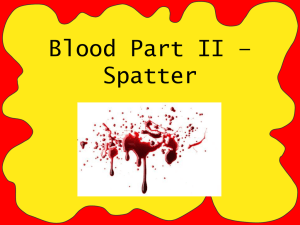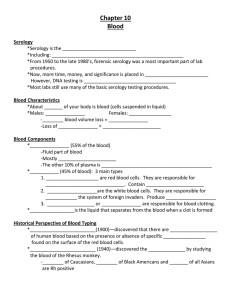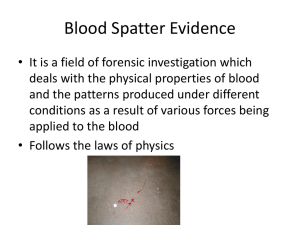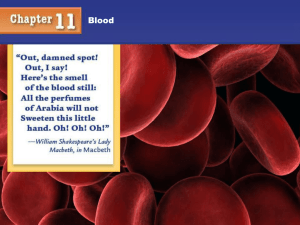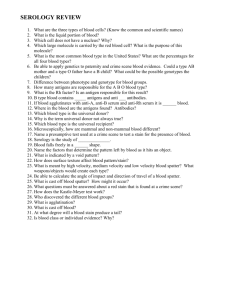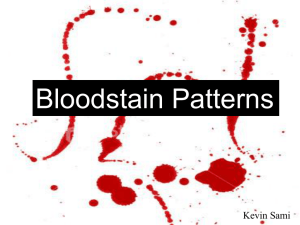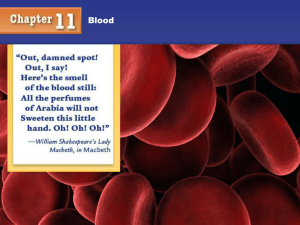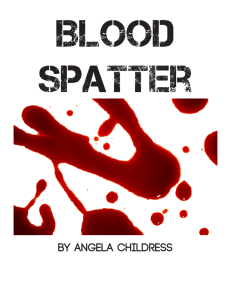Is it blood? - ksmithelvie
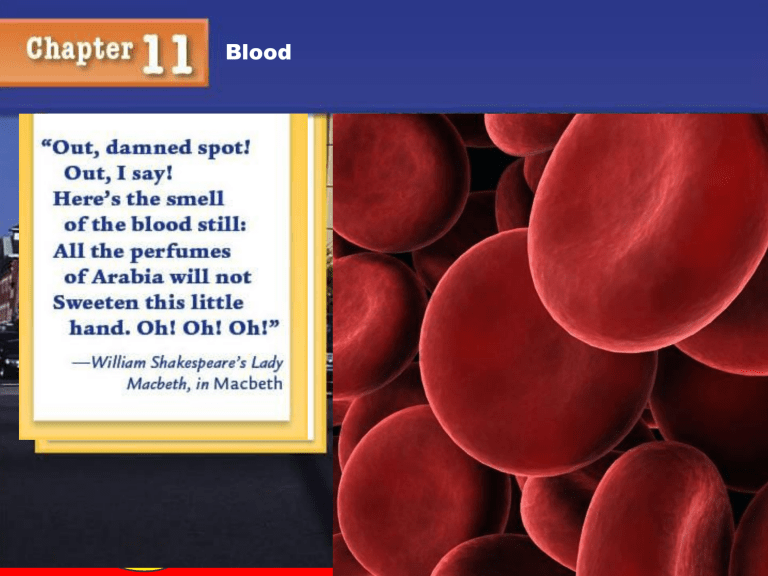
Blood
Blood
Objectives
You will understand:
That an antibody and an antigen of different types will agglutinate, or clump, when mixed together.
That the significance of the evidence depends on a characteristic’s relative occurrence in the population.
2
Blood
Objectives, continued
You will be able to:
Determine whether a stain is blood.
Determine whether a bloodstain is human or animal blood.
Determine the blood type of a simulated bloodstain using the
ABO/Rh system.
Explore bloodstain patterns as a function of velocity, direction, and height of fall.
Use technology and mathematics to improve investigations and communications.
3
Blood
Serology
Serology is the examination and analysis of body fluids.
A forensic serologist may analyze a variety of body fluids including saliva, semen, urine, and blood.
From 1950 to the late 1980s, forensic serology was a most important part of lab procedures. With the development of DNA techniques, more time, money, and significance were placed on developing DNA labs.
However, with limited funds and the time required for DNA testing, most labs still use many of the basic serology testing procedures.
4
Blood
Blood Characteristics
Approximately one-twelfth of our body is blood
Blood is composed of cells suspended in liquid
Plasma is the fluid portion of the blood
(55 percent).
The solid portion is made up of three principal types of cells (45 percent)
Serum is the liquid that separates from the blood when a clot is formed.
5
Blood
Blood Characteristics Plasma is composed of 90 % water and
10 % metabolites, waste, salts, ions and proteins.
Cells: a. Erythrocytes or red blood cells. They contain hemogloblin and are responsible for transporting oxygen from the lungs to the cells and also for the removal of carbon dioxide from the cells. b. Leukocytes are the white blood cells; they are the primary cells of the immune system and are responsible for “cleaning” the system of foreign invaders.
c.Thrombocytes or platelets are responsible for blood clotting.
6
Blood
Historical Perspective of Blood Typing
Around 1900, Karl Landsteiner discovered that there are four different types of human blood based on the presence or absence of specific antigens found on the surface of the red blood cells.
Lansteiner came up with the ABO classification for blood.
In 1940, Landsteiner and Weiner reported the discovery of the
Rh factor by studying the blood of the Rhesus monkey. 85 percent of Caucasians, 94 percent of Black Americans, and 99 percent of all Asians are Rh positive.
7
Blood
Blood Terminology
ABO blood groups —based on having A, B, both, or no antigens on red blood cells
Rh factor —may be present on red blood cells; positive if present and negative if not
Antigen —a substance that can stimulate the body to make antibodies.
Certain antigens (proteins) found in the plasma of the red blood cell’s membrane account for blood type.
Antibody —a substance that reacts with an antigen
Agglutination —clumping of red blood cells; will result if blood types with different antigens are mixed
8
Blood
Unknown Stain at a Scene
Questions to be answered:
Is it blood?
Is it human blood?
Whose is it?
Determine blood type, alcohol content, drugs present
Determine the method(s) in which blood may have been deposited
9
Blood
Presumptive Tests for Blood Determination
Kastle-Meyer color test —a mixture of phenolphthalein and hydrogen peroxide; the hemoglobin will cause the formation of a deep pink color if blood is present
Hematest tablet —reacts with the heme group in blood, causing a bluegreen color
Luminol test —reaction with blood to produce light
10
Blood
Human versus Animal Blood
Microscopic observation
Precipitin test
blood is injected into a rabbit
antibodies are formed and the rabbit’s blood is extracted as an antiserum
the antiserum is placed on sample blood. The sample will react with human proteins if human blood is present. This test is very sensitive and requires only a small amount of blood.
11
Blood
Blood Typing
Blood type A has antigen A on the surface of the cell and will agglutinate with blood type B.
Blood type B has antigen B on the surface of the cell and will agglutinate with blood type A.
Blood type AB has antigens A and B on the surface of the cells and will not agglutinate with either type A or type B blood.
Blood type O has neither antigen A nor B and will agglutinate with either A or B
.
12
Blood
Blood Groups
Type Antigen Antibody
Can Give
Blood To
Can Get
Blood From
A A B A, AB O, A
B B O, B
AB
O
A and B
Neither
A nor B
A
Neither
A nor B
A and B
B, AB
AB
A, B, O, AB
A, B, O, AB
O
13
Blood
Population Distribution of Blood Types in the
U.S.
Type Percent
O 45
A
B
AB
40
11
4
14
Blood
Animal Blood
Frog blood
Larger nucleic red blood cells
15
Blood
Human Blood
Red blood cells are most numerous; 5 to 6 million per mm 3
White blood cells are larger and less numerous; 5,000 to
10,000 per mm 3
Platelets are tiny, cellular fragments; 350,000 to
500,000 per mm 3
16
Blood
Blood Pattern Reconstruction
Scene Pattern
Reconstruction
1. Stain condition
2. Pattern
3. Distribution
4. Location
5. Directionality
Lab Results
Reconstruction
1. Genetic marker typing
2. Age determination
3. Source determination
4. Race determination
5. Sex determination
—From
Cracking Cases by Dr. Henry C. Lee and
Thomas W. O’Neil
17
Blood
Blood Spatter Evidence
A field of forensic investigation that deals with the physical properties of blood and the patterns produced under different conditions as a result of various forces being applied to the blood.
Blood, as a fluid, follows the laws of physics.
18
Blood
Blood Droplet Characteristics
A blood droplet remains spherical in space until it collides with a surface.
Once a blood droplet impacts a surface, a bloodstain is formed.
Droplets falling from the same height, hitting the same surface at the same angle, will produce stains with the same basic shape.
How will the shape change as the height is increased or decreased?
19
Blood
Conditions Affecting Shape of Blood Droplet
Size of the droplet
Angle of impact
Velocity at which the blood droplet left its origin
Height
Texture of the target surface
• On clean glass or plastic —droplet will have smooth outside edges
• On a rough surface —will produce scalloping on the edges
20
Blood
Questions Answered by Blood
Spatter Interpretation
The distance between the target surface and the origin of the blood
The point(s) of origin of the blood
Movement and direction of a person or an object
The number of blows, shots, etc., causing the bloodshed and/or the dispersal of blood
Type and direction of impact that produced the bloodshed
The position of the victim and/or object during bloodshed
Movement of the victim and/or object after bloodshed
21
Blood
Bloodstain Terminology
Angle of impact —angle at which blood strikes a target surface
Bloodstain transfer —when a bloody object comes into contact with a surface and leaves a patterned blood image on the surface
Backspatter —blood that is directed back toward the source of energy
Cast-off —blood that is thrown from an object in motion
22
Blood
Bloodstain Terminology, continued
Contact stain —bloodstains caused by contact between a wet bloodbearing surface and a second surface that may or may not have blood on it
• Transfer —an image is recognizable and may be identifiable with a particular object
• Satellite Spatter —Small droplets of blood that are distributed around a drop or pool of blood as a result of the blood impacting the target surface
• Swipe —wet blood is transferred to a surface that did not have blood on it
• Wipe —a non-blood-bearing object moves through a wet bloodstain, altering the appearance of the original stain
23
Blood
Bloodstain Terminology, continued
Directionality —relates to the direction a drop of blood travels in space from its point of origin
Terminal velocity —the greatest speed to which a free-falling drop of blood can accelerate in air. It is dependent upon the acceleration of gravity and the friction of the air against the blood —approximately
25.1 feet/second.
• High velocity —greater than 25 feet per second, usually
100 feet per second; gives a fine mist appearance
• Medium velocity —5 to 25 feet per second
• Low velocity —5 feet per second or less
24
Blood
Bloodstain Patterns
The shape of a blood drop:
Round —if it falls straight down at a 90-degree angle
Elliptical —blood droplets elongate as the angle decreases from 90 to 0 degrees; the angle can be determined by the following formula:
25
Blood
Impact
The more acute the angle of impact, the more elongated the stain.
90-degree angles are perfectly round drops; 80-degree angles take on a more elliptical shape.
At about 30 degrees the stain will begin to produce a tail.
The more acute the angle, the easier it is to determine the direction of travel.
26
Blood
Bloodstain Patterns
The harder and less porous the surface, the less the blood drop will break apart.
The softer and more porous the surface, the more the blood drop will break apart.
The pointed end of the bloodstain faces the direction of travel.
27
Blood
Area of Intersection and Convergence
The location of the blood source can be determined by drawing lines from the various blood droplets to the point where they intersect.
The area of convergence is the point of origin —the spot where the
“blow” occurred. It may be established at the scene by measurement of angles with the use of strings.
28
Blood
Blood Evidence
Class evidence for blood includes blood type. If you can determine the DNA, you will have individual evidence.
Bloodstain patterns are considered circumstantial evidence in a courtroom.
Experts can argue many points, including direction of travel, height of the perpetrator, position of the victim, left/right hand, whether the body was moved, etc.
29
Blood
Secretors
Eighty percent of the population are secretors. Their blood-type antigens are found in high concentration in their body fluids such as saliva, semen, vaginal secretions, and gastric juices.
30
Blood
More about Serology
For additional information about blood evidence, and famous crimes that involve serology, check out truTV’s Crime Library at: www.crimelibrary.com/criminal_mind/forensics/serology/1.html
31
Blood
Identify each of the following blood spatter pattern
32
Blood
Physical examination of Blood Lab
.
High velocity blood spatter
Transfer
Wipe
Passive droplet from 8 Ft at 90 degree angle
Passive droplet from 4 Ft at 90 degree angle
Cast off blood at approximately 80 degree angle
Cast off blood at approximately 30 degree angle
Satellite spatter
Blood dripping into blood
33

